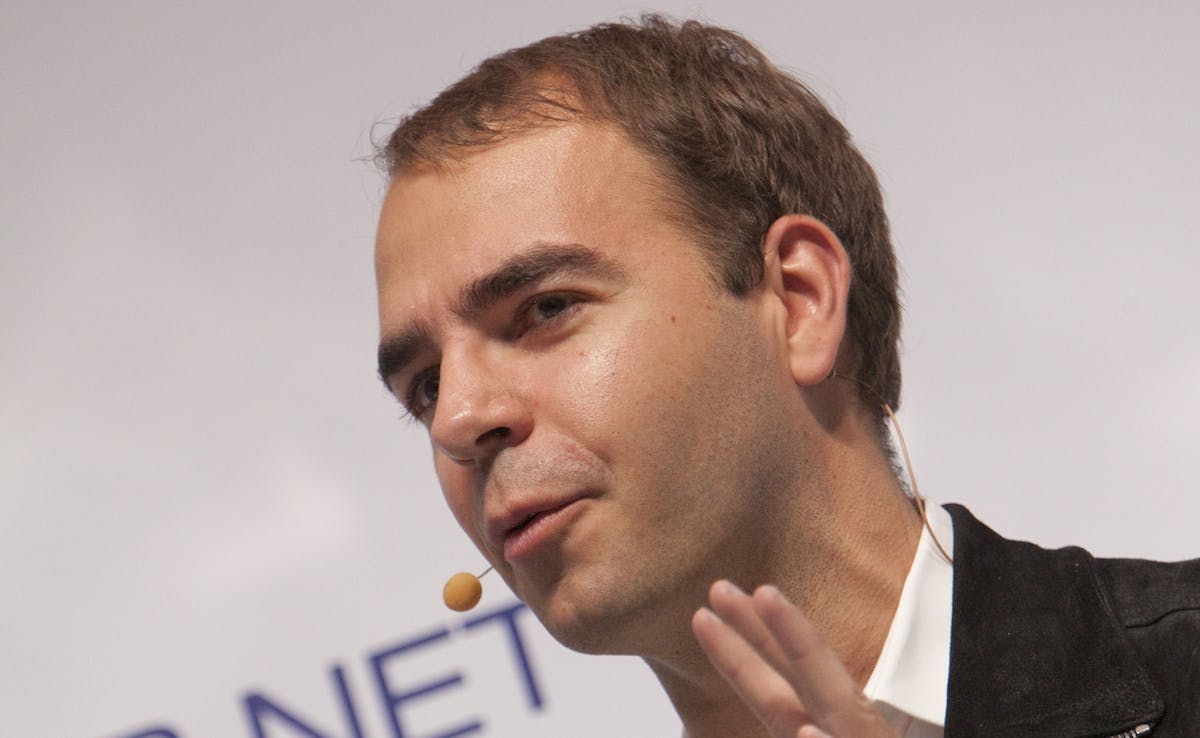Brian Rothenberg at the Marketplace Conference: Driving growth via buyer/seller overlap
Trust Eventbrite’s VP of Growth: if customers are turning to providers on your marketplace, you’re on to something magical.
Published on
Last updated on

This article series brings you some marketplace wisdom from the first Marketplace Conference in San Francisco. For our tips on growing your business, check out the marketplace marketing & growth articles library.
Many of the most successful platform businesses in the world have something in common: Brian Rothenberg from Eventbrite calls it cross-side demonstration virality. In a talk at the first Marketplace Conference in San Francisco, Rothenberg explained how to know if this is happening on your marketplace, and what to do to make the dynamic even stronger.
The Marketplace Conference unites marketplace founders, VCs, and subject matter experts to discuss the present and future of marketplaces and network effects. The first conference was organized in San Francisco in March 2018, with Sharetribe as one of the sponsors.
This article series brings you a recap of the top five talks we heard in San Francisco. Previously in the series, we outlined the talks by Upwork’s Jessica Tiwari, UrbanSitter’s Sarah Rose, Jackson Square Ventures’ Josh Breinlinger, and NfX’s James Currier. In this final article of the series, we discuss a powerful dynamic that has driven the growth of a number of successful marketplaces: the buyer-seller overlap.
Eventbrite is the largest live experiences platform in the world, both in terms of the number of events and number of event creators. In 2017, Eventbrite sold more than 200 million tickets across 180 countries.
In this talk, Brian Rothenberg, Eventbrite’s VP of Growth, discusses buyer-seller overlap. By this, he means a phenomenon where a marketplace is able to steadily convert a part of its customers into providers. (Rothenberg talks of buyers and sellers, but we prefer to use the terms “customer” and “provider” that also include the users of different types of peer-to-peer marketplaces, like services, rentals, and lending platforms.) According to the talk, this dynamic can bring a significant boost to a marketplace’s growth. We listed our favorite insights from the talk in this article.
Jump to:
- 1:04 for a discussion on the importance of network effects.
- 2:14 to learn about demonstration virality.
- 6:31 to learn how to identify cross-side demonstration virality on your platform.
- 9:37 to hear Eventbrite’s basic hypothesis when they started to experiment with improving their customer-provider conversion rate.
- 10:48 for a discussion on how to test tactics to increase conversions from customers into providers.
- 15:41 for great examples of consistent branding and key messaging.
- 19:51 for a discussion on analytics and segmentation.
- 22:04 for the Q&A.
When Uber first started, the company was known for their black cars. Lyft drove their customers around in cars that sported a pair of huge, pink mustache on their bumpers. Instagram made photos look so great that users wanted to share them on other social media networks as well.
These stories, according to Brian Rothenberg, have one thing in common: they are all examples of demonstration virality. That means that customers can’t help but show off the product or service to other potential customers when they use it.
Demonstration virality can be a great way to fuel one side of a marketplace. The real magic, according to Rothenberg, happens with what he calls cross-side demonstration virality.
Cross-side demonstration virality takes place when either side brings in both customers and providers. For example, the demand-side shows off the product and convinces others to not only join and become customers but also to convert into providers.
The beauty of cross-side demonstration virality is that it produces a loop. First, the existing supply-side markets the product to increase demand, like Eventbrite’s event hosts who market their event to their base of attendees. This brings new customers to the platform. Some of these customers then convert into new providers, who market their events to their attendees, who become new customers—and the wheel keeps turning. This way, growth on either the supply or the demand side fuels the growth of the entire platform.
According to Rothenberg, cross-side demonstration virality has been an important factor in Eventbrite’s growth as well as the growth of many successful platform businesses, from Airbnb to Etsy to GoFundMe.
As a general rule, Rothenberg says it will be easier to leverage this dynamic if it is already taking place on a platform organically. Attempting to create such a dynamic from scratch will probably not work.
The first thing to do, then, is to identify if this dynamic is already happening on a platform.
Same-side demonstration virality is relatively easy to spot: measuring your marketplace success through referrals and organic traffic from social channels, for example, can give a pretty good idea of whether your customers are showing off your product to their peers.
Cross-side demonstration virality is more subtle. There are usually far fewer providers on a marketplace than there are customers, so the number of customers who convert into providers is generally quite low. However, marketplaces often have significantly more customers than providers, so according to Rothenberg, even a small conversion rate from demand into supply could have a big impact.
That is why Rothenberg suggests, first, that marketplaces look to see if conversion from customers into providers is happening organically on your platform. If it isn’t, this growth strategy is probably not right for you.
–If it is happening, be very happy. This is a huge lever.
For the full discussion on what cross-side demonstration virality is, and how to identify it, jump to 2:14.
If you notice that cross-side demonstration virality is happening on your platform, how can you lean into it and leverage it for your growth?
For Brian Rothenberg, conversion from customers into providers is the cornerstone of this dynamic, so you should first focus on optimizing these conversions. The key is to make sure that customers understand how easy it is for them to become providers.
Business owners tend to think their customers understand their value proposition pretty well. Rothenberg says this is oftentimes not the case.
Rothenberg cites an example from Eventbrite’s old survey, where the company found out that 50 percent of their customers didn’t know that anyone can sell tickets to their event on the platform. The company realized that if the demand side doesn’t understand this basic logic of their platform, there is little chance of converting them.
Eventbrite's hypothesis became that if they can communicate their key message clearly to the customers, conversion from customers into providers will increase.
The hypothesis was put to the test. Eventbrite set up a cross-functional growth team, with Rothenberg as one of the members, whose core focus for a time was doing tests to increase conversion from customers into providers. They talked to 20 users that had converted and asked them about their experience. They then used the learnings from the interviews, and sometimes even the exact words the customers had used, to sharpen their messaging.
Eventbrite, for example, successfully tried out simple changes, like using their logo systematically on all pages. They added calls-to-action—”create an event” and “find events”—to visible locations on pages that get a lot of traffic, as well as pages that were considered low-value, such as expired listings pages. They also tested including their key message on order confirmation pages and PDF tickets.
In the talk, Rothenberg also shares great examples of key messaging from other companies. SurveyMonkey, for instance, encourages people who have filled in a survey to create their own survey at many stages in the customer journey, from survey question pages to the final “survey complete” page. For a time, Airbnb used a clever messaging tactic to support conversions: when customers contacted an Airbnb host to ask for more information about a listing, they got a pop-up message from Airbnb that suggested that they list their own home to pay for the trip they were planning. Platforms like Etsy and GoFundMe include their core message, like “Sell on Etsy”, on all of their listings pages—likely because marketplace listings pages have lots of traffic.
Overall, Rothenberg speaks for consistent branding and messaging at all points in the customer journey, from in-product messaging to notifications, emails, and retargeting.
He says that in order to convert into providers, customers need to know who you are, what you do, and how that can help them, and keep you top-of-mind when that need arises. That is why you should take advantage of different points in the customer journey to remind them about the chance to become providers.
For the discussion on communicating your value proposition, jump to 10:48.
Based on experiences with the growth team, Brian Rothenberg has a set of concrete recommendations on how to start experimenting with increasing conversions, and how to make these experiments more targeted.
First, he suggests finding a section on your platform that gets a lot of traffic, but where your brand and key message are not positioned very well. After that, you can start making experiments on how to improve the clarity of your core message on those parts first.
The impact of these experiments should be carefully tracked, even though it might seem challenging—especially on new marketplaces that don’t have many users. Rothenberg recommends looking at low-latency cohorts, meaning the actions customers take within a day or a week of their purchase. In his experience, if a conversion from a customer into a provider takes place, it will happen rather close to the point where customers are active on the platform. If your tests are impactful enough, you should be able to see their effect in conversion rates during and after a test period.
Later on in the talk, Rothenberg shares insights on how to make the trials more targeted. The key is to find out as much as possible about the people who convert from customers into providers, and the situation where that conversion happened.
For instance, are the customers that convert into providers high or low in value? How are all the converted people similar to one another? What attributes do they share? How many times did they make purchases, bookings, or rentals on the platform before they became providers?
Looking for answers to these questions will help you get better at predicting conversions, allowing you to segment the types of users that are most likely to convert and focus your activities on them.
On Eventbrite, for instance, the statistics show a clear predictive moment: after a certain number of ticket purchases, customers are significantly more likely to convert into providers than at any other point during their use of the platform. If you find out a predictive marker like this, you can use targeted marketing very efficiently. You could, for instance, send triggered, personalized notifications to the customers that reach a certain amount of repeat purchases on your platform.
With horizontal marketplaces, making purchases or bookings across categories can be another predictor of conversion. Rothenberg’s example is illustrative: when a user makes their first handmade jewelry purchase on Etsy, they will likely think that all Etsy does is to allow jewelry-makers to sell their wares. Making several purchases from different categories can help to inspire an “a-ha moment”: “oh, this platform can be used to sell almost anything!”
Rothenberg’s advice, then, is to get friendly with marketplace analytics and segmentation to further boost the activities that drive provider into customer conversion.
For the discussion on tracking your conversion rates, jump to 14:22 and 19:51.
This is the final article in our series covering our favorite talks from the first Marketplace Conference in San Francisco. To start from the beginning, read the first article in the series, which covers Jessica Tiwari's talk on building trust on marketplace platforms.
You might also like...

How to get started with Google Ads for your marketplace
The basics of setting up your first-ever Google Ads campaign.

“Make your marketplace unit economics work,” says Fabrice Grinda
When one of the world’s most successful angel investors talks marketplaces, we listen.

Make your members happy – An interview with Jim Pickell
Member satisfaction is the ultimate marketplace key performance indicator.
Start your 14-day free trial
Create a marketplace today!
- Launch quickly, without coding
- Extend infinitely
- Scale to any size
No credit card required
